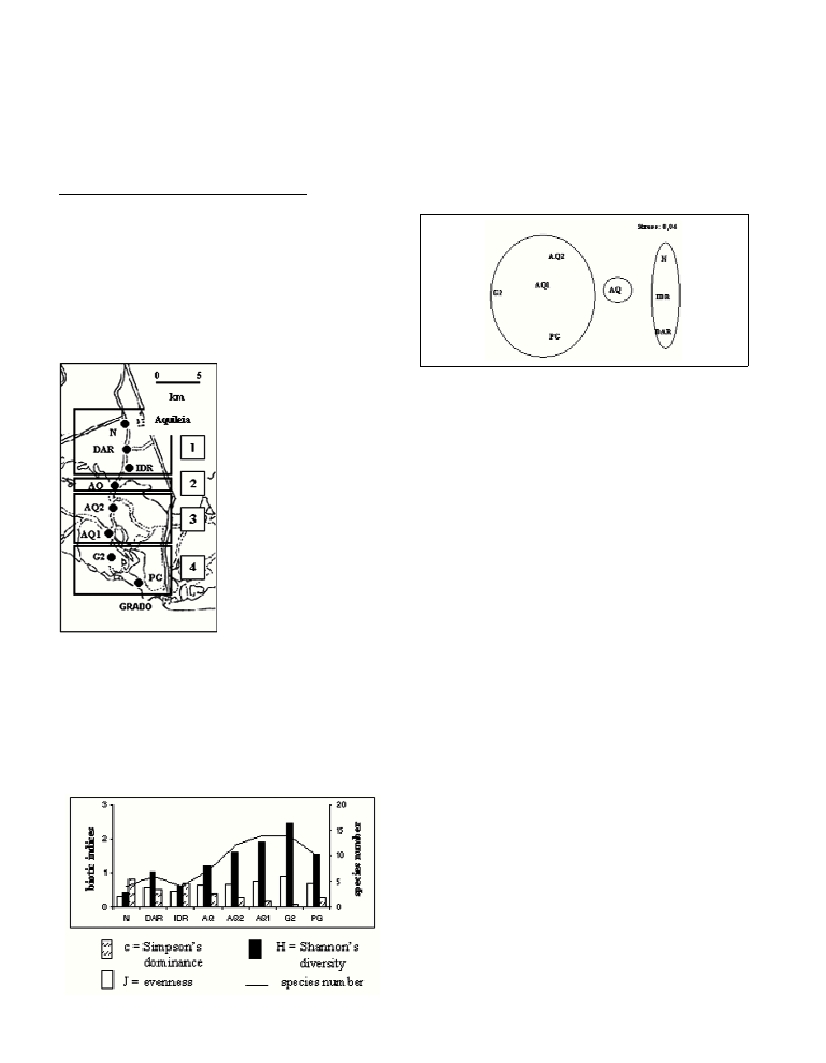THE ECOTONE GRADIENT IN THE LAGOON ESTUARY OF THE RIVER NATISSA IN NORTHERN ADRIATIC SEA
Renato Sconfietti
Department of Genetics and Microbiology, Section of Ecology, University of Pavia, Italy - renato.sconfietti@unipv.it
Abstract
This paper emphasizes the strict analogy between the ecological zonation along the lagoon estuary of the river Natissa and the Atlantic
schemes of estuarine zonation proposed by the literature. Like in other north Adriatic estuarine ecotones, the whole gradient is appreciable
in only a few chilometres.The conservative feature of the true estuarine pool is pointed out.
Keywords: estuary, lagoon, Adriatic Sea, ecotone
Rapp. Comm. int. Mer Médit., 37,2004
549
Introduction
Our previous papers pointed out the estuarine features of the Grado-
Marano lagoon [1, 2, 3], the second for wideness after the lagoon of Veni-
ce. This paper examines in detail its ecotonal communities on hard substra-
ta, to identifie analogies with the Atlantic schemes of estuarine zonation [4].
Materials and Methods
During the summer in 2000 and 2001, biological samples have been
obtained in eight stations (Fig. 1) from wooden piles, that mark the navi-
gable canals. The lagoon and the sampling methods are extensively
described in our quoted papers. Both sessile and mobile benthos have been
investigated; data were analysed with the Primer 5.0 software for the com-
munity structure, MDS and cluster analysis.
Results and Discussion
More than 80 species have been identified, almost equally divided in ses-
sile and mobile benthos. Among these, only a few species reach the town of
Aquileia, where cohabit with elements of the continental domain. The rich-
est communities, for both biomass and number of species, are placed in the
middle part of the gradient, in the full lagoon sector.
This pattern is well esemplified by some structural parameters of the
mobile communities (Fig. 2), whose distribution is less in?uenced by the
aggregation of many sessile species.
The proposed example of the MDS applied on the whole community for
2001 show a clear separation in two blocks of stations (Fig. 3): the conti-
nental and the lagoon ones. The central position of the st. AQ corresponds
to the topographical collocation, at the interface between the continental
and the lagoon course of the river Natissa. These assemblages are con-
firmed by the cluster analysis.
Therefore, the scheme proposed for Atlantic estuaries can be extended
to this Mediterranean pattern, notwithstanding the reduction of the longi-
tudinal extension.
In the upper stream, where salinities values range from 0 to 15 psu, a
poor but original pool of species can be pointed out, which is recurring in
analogous sectors of other estuaries [5]: the bryozoans of the family
Victorellidae, the hydrozoan Cordylophora caspia (Pallas), the polychaete
Ficopomatus enigmaticus(Fauvel), the tanaid Heterotanais oerstedi
(Kroyer) and the amphipod Leptocheirus pilosus(Zaddach).
A few euryhaline species colonize the whole gradient, such as the bry-
ozoan Conopeum seurati(Canu), the barnacle Balanus improvisusDarwin
and the tubicle amphipod Corophium insidiosum Crawford.
Most of the species have been collected in the full lagoon portion of the
estuary or near the sea mouth. Among these, the presence of the alloctone
bryozoan Tricellaria inopinata(d’Hondt & Occhipinti Ambrogi) [6] is
confirmed, together with a probable new species for the Mediterranean
Sea, the other bryozoan Anguinella palmatavan Beneden, whose identifi-
cation must be approved by specialists.
Conclusion
The four classic sectors proposed by Mc Lusky [4] have been here rec-
ognized (Fig. 1): 1) the head of the estuary; 2) the middle reach, corre-
sponding with the proper ecotonal transition; 3) the lower reach; 4) the
mouth, near the sea port. The recurring occurrence of the same pool of
species in the true estuarine portion of different estuaries signifies a strong
conservative composition, whose enrichment is obstructed mainly by
osmotic barrier coming from the marine domain toward the continental
waters. On the contrary, the lagoon portion of the estuary is open to bio-
logical novelties, because of the little selective salinity and the favourable
trophic conditions of the well vivified sectors.
References
1-Sconfietti R., Marchini A., Occhipinti Ambrogi A., and Sacchi C.F., 2003.
The sessile benthic community patterns on hard bottoms in response to
continental vs. marine in?uence in northern Adriatic Sea. Oceanologica Acta,
26: 47-56.
2-Gemelli A., Marchini A., Oleotto R., Sacchi C.F., Sconfietti R., and Tibaldi
E., 2001. Ècosystèmes d’estuaire sur substrat cohérent dans la lagune de
Grado-Marano (Adriatique du nord). Rapp. Comm. int. Mer Médit., 36: 386.
3-Sconfietti R., and Gemelli A., 2002. L’estuario del fiume Natissa nella laguna
di Grado-Marano (Mare Nord-Adriatico): gradienti biocenotici di substrato duro.
Studi Trentini di Scienze Naturali – Acta Biologica, 78: 219-226.
4-Mc Lusky D.S., 1971. The estuarine ecosystem. Blackie & Son, Glasgow
and London: 1-131.
5-Sconfietti R., 1989. Ecological zonation and dynamics of hard-bottom
Peracarid communities along the lagoon estuary of the river Dese (Lagoon of
Venice, northern Adriatic sea). Riv. Idrobiol., 28: 3-31.
6-Occhipinti Ambrogi A., 2000. Recent developments in the history of the
Bryozoans of the lagoon of Venice: biodiversity and environmental stress. Pp.
305-315. In: Proceedings of the 11
th
International Bryozoology Association
Conference. Allen Press, Lawrence Kansas.
Fig. 1.
The eight sampling
stations with the four
sectors (1-4)
described in Conclusion.
Fig. 2. Biotic indices for the mobile benthos in 2001.
Fig. 3. MDS graph on both sessile and mobile benthos in 2001.

